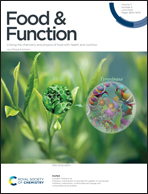A comprehensive investigation of gluten free bread dough rheology, proving and baking performance and bread qualities by response surface design and principal component analysis†
Abstract
Contribution of methylcellulose (MC), psyllium seed husk powder (PSY), and water addition level to gluten free bread quality and correlations between dough rheological properties and bread qualities were investigated by response surface design and principal component analysis. The generalised Maxwell model was applied to estimate the relaxation frequency of gluten free doughs. The addition of PSY has a complex influence on pasting viscosity at high temperature and an additional peak was observed. MC significantly influenced dough extensibility and work of adhesion, which are good predictors of bread volume and textural properties. Other rheological responses are less significantly correlated to specific volume, but they are sensitive to formulation variations, reflect dough structures and stability, related to proving behaviours, and correlated to loaf concavity. An inappropriate combination of water and hydrocolloids might lead to problems such as low stability of doughs, overexpansion, and weak crumb structure at high water addition levels, or, in contrast, high rigidity of dough, a trap of excessive air during mixing, and restrained gas cell expansion with high hydrocolloid addition and low water addition.

- This article is part of the themed collection: Food & Function Recent Open Access Articles


 Please wait while we load your content...
Please wait while we load your content...